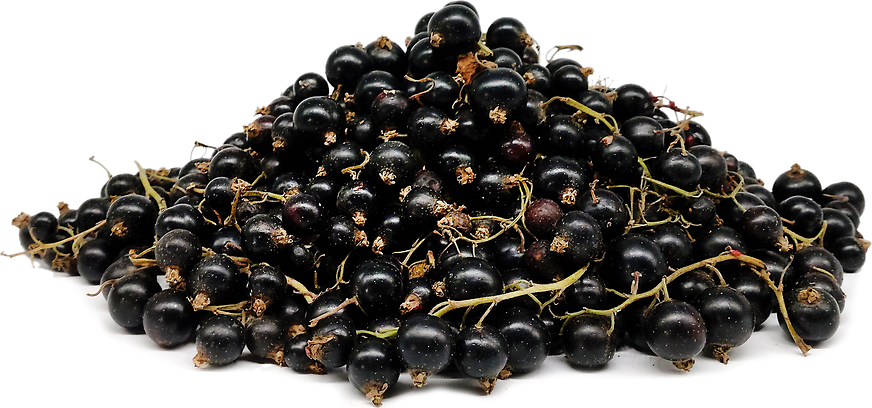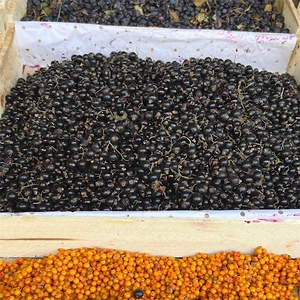


Tiben Currant Berries
Estimated Inventory, ea : 0
Description/Taste
Tiben black currants are oval to globular berries, growing in loose clusters on wide, leafy bushes. The berries are considered to be slightly larger than other black currant varieties, causing the wide-spreading branches of the bush to droop when the berries are ripe. The skin of the berry is smooth, shiny, and taut with a black, dark purple hue. Underneath the surface, the flesh is firm and aqueous, filled with small, edible seeds, and contains a purple-black tone. When ripe, Tiben black currants have a mild, musky, and earthy, sweet and sour flavor with a subtly acidic, fruity aroma.
Seasons/Availability
Tiben black currants are available in the summer.
Current Facts
Tiben black currants, botanically classified as Ribes nigrum, are a mid to late season variety that belongs to the Grossulariaceae family. The large, nutritionally dense berries have become a favorite variety for both commercial farms and home gardens in Eastern Europe and Central Asia. Tiben black currants are known for their high yields, easy-to-grow nature, resistance to disease, and sweet-tart flavor. Once harvested, the currants can also withstand transport, allowing growers to export them to neighboring cities where the berries are sold at a premium for use in making jams, juices, compotes, and desserts.
Nutritional Value
Tiben black currants are an excellent source of anthocyanins, which give the berries their dark hue and provide antioxidant-like properties to protect the body against environmental damage. The berries are also a good source of vitamin C, which can help protect the immune system, and contain potassium, zinc, magnesium, and vitamin E.
Applications
Tiben black currants are best suited for cooked applications such as simmering or boiling. The berries can be eaten fresh, out-of-hand, but some of the berries may contain a sour, tangy flavor. The sweet-tart nature of the berries makes them suitable for cooking into syrups, jams, compotes, and liqueurs. Once reduced, Tiben black currant syrups and jellies can be spread over bread and scones, mixed into baked goods, or stirred into cocktails. The berries can also be baked into pies, muffins, and crumbles, blended into smoothies, or pressed and used as a flavoring in juices. Beyond sweet preparations, Tiben black currants add a natural astringency to sauces and complement the flavor of roasted meats. They can also be dried or frozen for extended use. In Europe, black currants are frequently infused with spirits and crushed to create a liqueur known as crème de cassis. Tiben black currants pair well with meats such as ham, pork, duck, and venison, dark chocolate, herbs such as rosemary and sage, coconut, citrus, apples, vanilla, and sharp cheeses. Fresh Tiben black currants will keep up to one week when stored in the refrigerator. The berries can also be frozen in a sealed container for up to six months.
Ethnic/Cultural Info
Karagat Fest is an annual berry event held in the Issyk-Kul province of Kyrgyzstan. First promoted in the late summer of 2013, the festival was created to celebrate the local produce grown in the region while encouraging continued cultivation and agricultural partnerships. During Karagat Fest, visitors can participate in masterclasses where they can learn how to make juices and jams, network with farmers, and learn how to improve and expand preexisting gardens for commercial and personal use. Over two thousand visitors attend the festival, and berries such as Tiben black currants are highlighted each day through the vendor’s homemade confections, drinks, and compotes.
Geography/History
Tiben black currants are a cross between the varieties titania and ben nevis and were created in 1987 at the Research Institute of Pomology and Floriculture in Skierniewice, Poland. The berries continued their trial testing at participating orchards, and in 1996, Tiben black currants were officially registered as a variety in Poland. Tiben black currants were later introduced to Central Asia, specifically Kyrgyzstan, in 2013, where the variety became favored for its adaptability and rapid growth. Today Tiben black currants can be found through specialty growers in Central Asia, Europe, and the United States.








